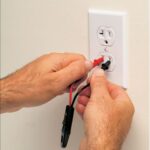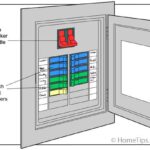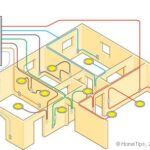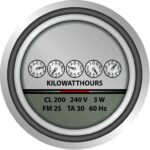Having a map of your home’s electrical circuits can help you quickly and easily identify the source of a problem.
Have you ever found yourself fumbling with a flashlight at your home’s electrical panel to find a circuit breaker that has tripped so you can reset it? Or have you needed to shut off a circuit breaker that controls a group of lights or receptacles so you can make a repair—but you don’t know which breaker serves that circuit? Luckily, there’s a simple way to get control of this situation: creating a map of your home’s electrical circuits. With a circuit breaker map, you can always quickly identify which breaker controls which outlets, lights, and appliances, saving you time and frustration.
What do you need?
| TOOLS AND MATERIALS YOU’LL NEED | Pen and paper Flashlight Transparent tape |
| OPTIONAL | A buddy (this is easier with 2 people) Label maker (or permanent marker) Radio (if you’re working alone) |
Safety first
Locate the main electrical panel, which is usually in the garage, laundry room, or a utility closet. Turn off any major appliances before you begin (like washing machine, dryer, oven, or dishwasher). Make sure the breaker panel door is cool to the touch before you open it. If it isn’t, call an electrician.
Make sure there are no exposed wires inside the panel—the cover plate in the panel should be concealing all of the wires. Touch only the circuit breaker switches.
The Plan of Attack
This job of mapping circuit breakers to your home’s circuits is easiest to do if you have a helper. One person stands at the electrical panel, where they systematically turn off each circuit breaker while the other person checks to see which lights, outlets, or appliances lose power. If you don’t have a helper, get ready for a workout because you’ll be scurrying back and forth from the electrical panel to all of the rooms.
Expert Tip: If you’re working alone, plug a radio into an outlet, turn it up loud, and then head to the breaker panel. Turn off the breakers one by one until the radio goes silent. That’s the breaker that controls that outlet. Then go back to that room and try the radio in the other outlets located near the first one to identify the other outlets that are on the same circuit.
If the circuit breakers aren’t already numbered inside the electrical panel, number them. Make
For a thorough mapping, you can sketch a floor plan and make notes on it that identify the breaker numbers for each light and receptacle throughout the house. A simpler procedure is to make a list that you can post on the inside of the door—noting which devices each numbered breaker controls.
Expert Tip: Electricians often mark the back of each switch and receptacle cover with the circuit breaker number that controls it.
Be aware that all of your home’s lights and outlets will be turned off at some point, so when you’re done you’ll probably have to reset plug-in clocks, lighting and sprinkler timers, and the like.
To make your mapping easier, be aware that receptacles are usually one-after-another on circuits that are separate from lighting, and major appliances such as furnaces, microwaves, washing machines, electric dryers, and electric ovens often have their own dedicated circuits.
Step-by-Step Circuit Mapping
Here’s how to map circuit breakers, step-by-step.
1 Identify any large, double (240-volt) circuit breakers first. Flip one on. Determine which major electrical appliance(s) it supplies by turning on each electrical appliance (don’t forget equipment such as the furnace and the pool pump) until you find the right one(s). Repeat with the other large circuit breakers and major appliances.
2 Have your helper plug a small lamp (or any small electrical device) into a standard room receptacle. Turn breakers on and off until you find the one that turns on the device. Leave that breaker on and have your helper plug the device into other receptacles; note all the ones controlled by that breaker. Note: You can buy a simple, inexpensive tool called a “circuit tester” to easily check receptacles for power.
3 Repeat this process, switching on room lights one by one, and note the circuit breaker that controls each set of lights.
4 Tape the completed map on the inside of the electrical panel door. For added convenience, use a label maker (or a permanent marker) to mark next to each breaker the circuit that it controls (such as “Bathroom lights”).
The circuit map in the floor plan above is of a typical two-bedroom house. Note that the dashed lines indicate which switch controls which fixture; they do not show wire routes.
How to Map House Electrical Circuits FAQ
- What is an electrical circuit?
An electrical circuit is a complete path where electricity travels in a circle. It moves along a “hot” wire toward a light or receptacle, supplies energy to the device (called a load), and then returns along the “neutral” wire to the source. In house wiring, the term “electrical circuit” usually refers to a group of lights or receptacles connected along such a path.
- Why is it important to map your home’s electrical circuits?
Mapping your home’s electrical circuits can help you quickly identify the source of a problem and find the right circuit breakers or fuses to shut off or reset when needed.
- What should you do if your service panel doesn’t have a reference for which circuit breakers control which circuits?
If your service panel doesn’t contain a reference for which circuit breakers control which circuits, it’s a good idea to create a list that you can post on the inside of the door. The list should have numbers corresponding to each circuit breaker and notes on which devices the breaker controls.
- How can you create a more thorough circuit map?
For a more thorough mapping, you can sketch a floor plan and make notes on it that identify the breaker numbers for each light and receptacle throughout the house. Tape this map on the inside of the electrical panel’s door.
- How are receptacles and lighting typically connected to circuits?
Receptacles are usually on circuits separate from lighting, and major appliances such as furnaces, microwaves, washing machines, electric dryers, and electric ovens often have dedicated circuits.
- What should you be cautious of if your electrical panel has old circuit breakers?
If your electrical panel has old circuit breakers, flipping them off and on can break them, and obsolete circuit breakers may be difficult to replace, so proceed with caution.



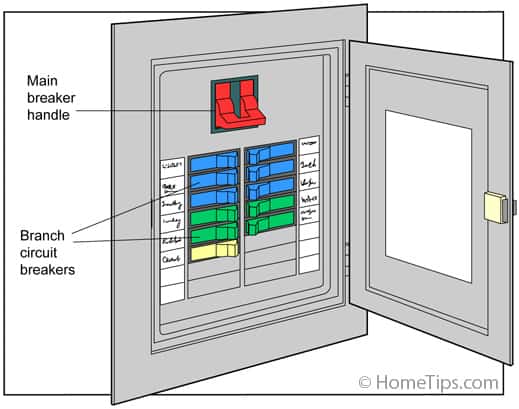
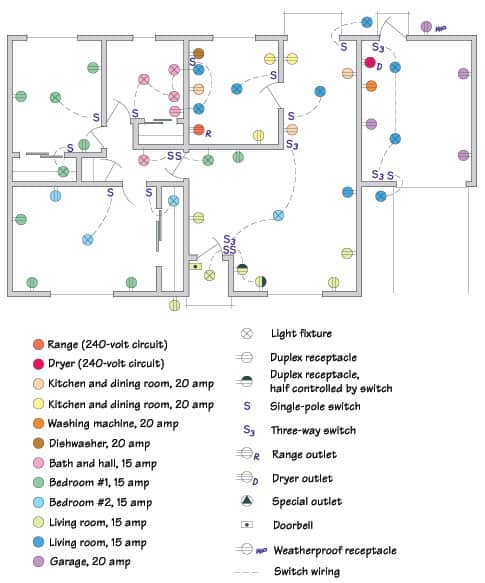
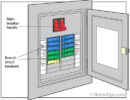
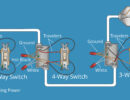

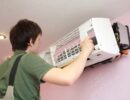
 Don Vandervort writes or edits every article at HomeTips. Don has:
Don Vandervort writes or edits every article at HomeTips. Don has:
